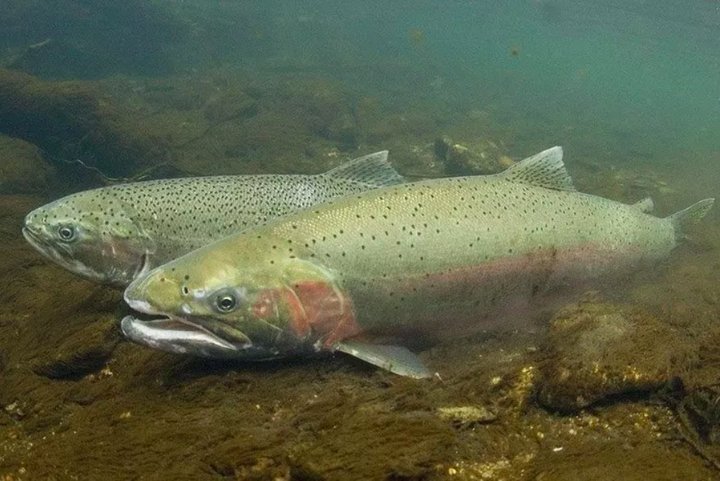
Male and female steelhead. | Image courtesy NOAA.
A trio of federal wildlife management agencies said Friday that listing the Northern California summer-run steelhead on the Endangered Species Act may be warranted, but said more public input is needed before a final determination is made.
Wildlife conservation group Friends of the Eel River petitioned to list the Northern coast population of steelhead as endangered in November 2018. According to the group, fewer than 1,000 adult steelhead spawn in all of the coastal rivers they still inhabit in California, from Redwood Creek in the north to the Mattole in the south.
The group blames Scott Dam for the population’s decline because it blocks 98% of potential habitat for the steelhead. They note the population was almost wiped out during dam construction.
In a 13-page unpublished proposed rule issued Friday, the National Oceanic and Atmospheric Administration, the Department of Commerce and the National Marine Fisheries Service said a potential endangered status listing is warranted.
“We find that the petition presents substantial scientific information indicating the petitioned action may be warranted,” the proposed rule said. “We will conduct a status review of Northern California summer-run steelhead to determine if the petitioned action is warranted.”
The 90-day finding is subject to further review and the agencies will accept input from commercial and scientific communities for up to 60 days beginning April 23, the date the proposed rule is expected to be published in the Federal Register.
Populations of steelhead across the West Coast have been under review for listing as Evolutionarily Significant Units by the agencies since 1996.
According to the proposed rule, the agencies determined in 1998 that the Northern Californian steelhead population “did not warrant listing under the Endangered Species Act because available scientific information and conservation measures indicated the Evolutionary Significant Unit was at a lower risk of extinction than at the time of the proposed rule.”
But the National Marine Fisheries Service reconsidered the decision in 2000 and, after considering public comment on the issue, decided to list the steelhead population as a threatened species – a lower category of federal protection.
Friends of the Eel River presented new genetic evidence that the summer-run steelhead populations may qualify for a separate listing from the winter-run populations, a significant factor in the agencies’ preliminary determination.
All steelhead hatch in gravel-bottomed, fast-flowing rivers and streams but develop in ways that adapt to their environments. Winter-run populations require different conservation plans than summer-run populations.
The petition cited a study that found summer-run steelhead populations may never rebound, or will recover too slowly if they lose access to spawning grounds they return to after swimming into the ocean.
This compelled the agencies to further review the petition and the status of the populations.
“After reviewing the information contained in the petition, as well as information readily available in our files, we conclude the petition presents substantial scientific information indicating that the petitioned action to delineate a Northern California summer-run steelhead distinct population segment may be warranted,” the proposed rule said.
# # #
Note: This post has been edited to remove all references to trout since, according to Scott Greacen of Friends of the Eel River, the summer steelhead are technically not trout, though they were long classified as such. They’re now grouped with all of the Pacific salmonids in the Oncorhynchus genus, meaning they’re freshwater salmon, Greacen says, and we’re taking his word for it.
CLICK TO MANAGE